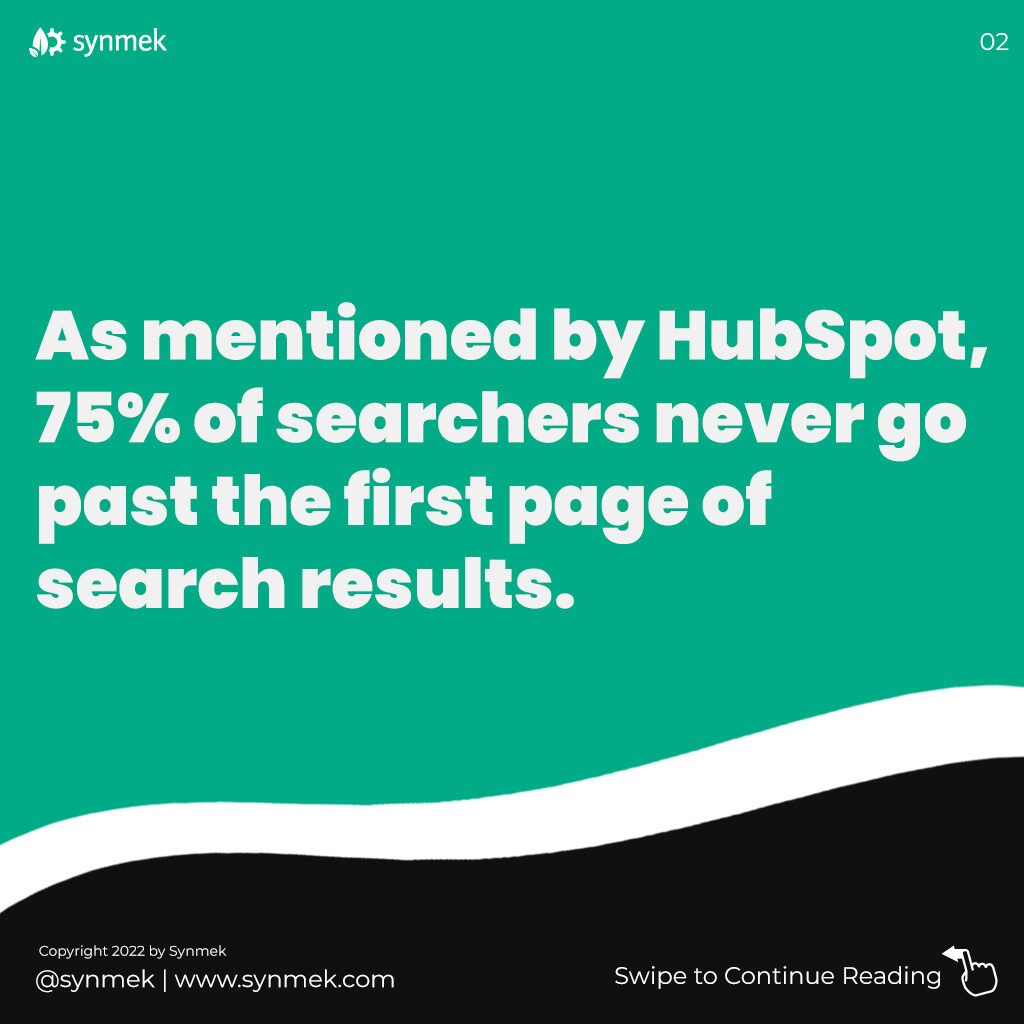Business • Research •
A Blueprint for Small Business Success
Digital Marketing • SEO •
As a small business owner, you want your website to succeed. According to the latest study by HubSpot, almost 80% of searchers never go past the first page of Google’s search results. This is why SEO has become a necessity for online success. With SEO [Search Engine Optimization], you can have your business website rank on the first page. In order to get ahead of your competition, you need to follow SEO best practices as a minimum. Let’s take a look at what these SEO Best practices are and how they can help your business outshine the competition.

When it comes to Google showing the correct result, their algorithm needs to match your content with the user’s search intent. Search intent is what the user is looking for and not necessarily what they’re typing in. For example, if a user is searching for best chocolate chip cookies, Google will most likely present them with results that show recipes. Rather than showing them places to buy the best chocolate chip cookies. Overtime, the Google algorithm tags and categorizes that user with what content they’re more likely to engage with.
Optimizing images is an ever evolving task and a hallmark of SEO Best Practices. It not only involves serving the right sized images, but images that have been optimized for file size, file format and resolution. These play a key role in your website’s load times. A good method to serve your website images, is to use a service such as TinyJPG or TinyPNG to minimize the file size. You can also consider serving your images in the WEBp format, which is a preference by Google. If you have graphic images [illustrations], try to serve them as SVGs [Scalable Vector Graphics] as they have a very small footprint on your website. We also recommend lazy-loading image files, as this can help speed up the load time of your website. Remember, faster website loading means an overall better user experience and a higher chance of Google ranking you above your competitor. Don’t forget to include ALT tags in your images, as these help users who utilize screenreaders, as well as, Google bots to understand the image on the page.
According to the latest insights on user experience, if a user is not served the web page in under 3 seconds, they’re very likely to click away or close the browser window. In some instances, especially mobile, that time is decreased to 1-2 seconds. You need to understand how your website is performing and if there are any immediate steps you can take to reduce the load times. Use a tool such as Google’s page speed insights or GTMetrix to run a performance audit. These tools list out all the changes you can make to speed up your website. Luckily, Synmek also offers a FREE website performance audit tool for you to use. As a rule of thumb, you want your loading speed to rated anywhere between 90-98 on the pagespeed insights scale. If you can get 100, then bravo, you’re a unicorn in a huge group of stallions.
User experience is one of the most important factors when it comes to customer retention, loyalty and conversion. If your website isn’t the easiest to navigate, has confusing & complicated linking structures or seems outdated, then you’re guaranteed to drop in rankings on Google. When it comes to understanding how your users interact with your website, search engines tend to look at bounce rates. Bounce rate is calculated using the time a user spent on your website without clicking on an internal link. The higher your bounce rate, the lower your search rankings. This tells search engines that the user did not find what they’re looking for or the content wasn’t engaging enough. Use Google’s Analytics to understand your bounce rates. You can also use a service like HotJar to see how users actually engage with your website and note where you can make improvements.
Short, concise and informative URLs are super important for your search engine rankings. In some cases, they should be memorable and easily accessible to a user, as well as, to Google’s crawling bots. Make sure your target keyword is in the URL. The URL needs to be readable without having filler words such as and, but, or. You’ll also want to include categories or subfolders if necessary. For example, if you have an online e-commerce website, you can have yourwebsite.com/product-category/product-title which will help Google and your users.
When Google displays your page link on their search results, they typically only show about 60 characters. Keep this in mind when you’re writing out your page titles. You want to keep your page titles concise and as informative as possible. Avoid keyword stuffing and creating duplicate title tags. Make sure your title tags also include your target keywords for that page. For example, if our target keyword is Custom Web Design, then we want to make sure the page that is all about Custom Web Design has that keyword in it. As for meta descriptions, these should be written in a way to interest and inform users with a summary of what the page is about. Your meta descriptions should be unique and should include your target keywords as well. They need to be written in a way that is action-oriented and provides an accurate summary of the page content.
The more quality backlinks a website has, the more likely Google will rank your page higher in search results. However, not every backlink is beneficial. You need to be getting backlinks from high-authority, credible websites. For example, a backlink from Forbes has a lot more weight than a backlink from an unknown website. The best way to get backlinks, is to write high quality, informative & engaging content. You can also reach out to industry authority websites manually and see if they can offer you a backlink on their pages. Sometimes, the content you write is more up to date than an article these high authority websites are linking to, so you can let them know. See if they will update their article to include your link, rather than the outdated one. You can also offer to write guest posts on news sites, blogs and industry authority websites where you can include a link back to your website.
As Google’s bots crawl your content and website, they can jump from one page to the other by following your links. Using internal linking structures to connect various pages throughout your website, you help Google find and categorize these pages. They can be linked to specific keywords that these pages are targeting and this in turn will offer some ranking juice to those pages. As for external links, they’re especially helpful for your readers. Including a quote or statistic from a resource? Link to that resource to give your reader more insights. Just remember to have that link open in a new window, so that your user can return to your content easily without having to go back.
Content marketing has become one of the most effective ways of driving traffic to your website. It helps build your business credibility & trust. It also helps build your authority within the industry you’re in. Providing users with helpful, insightful and actionable content goes a long way, both in their eyes and the eyes of Google. If you’re writing content on a platform like WordPress, use the Yoast SEO plugin to understand your content readability. You want to make your content easy to digest and relatable to the reader. You want to write your content in an active voice, which has been proven to engage a reader more than using a passive voice. Don’t forget to share your content across a variety of platform as well, to get more eyes on it.
Always be auditing your website to see where you can improve. Having your site audited for both SEO, Performance or content can help you get a better idea of what needs to improve. Auditing your website regularly also helps you see what’s working and what isn’t. You will need to use a variety of tools to conduct these audits, such as Pagespeed Insights, MOZ, Ahrefs or SEMRush. You can also reach out to us here at Synmek, where we can provide you with a complete website & content audit. Conducting a regular site audit is a key component of SEO Best Practices.
SEO is an evolving task and there are new changes every day. Stay on top by always learning the latest in the industry and following key blogs. Google is always updating what their ranking factors are, so it is important to stay up to date and ahead. In most cases, some of these best practices have been relevant for years and continue to be effective for increasing your rankings. However, as the world evolves, there are new avenues to pursue in order to succeed with search engine marketing. Keep this in mind when it comes to SEO Best Practices.
SEO Best Practices outlined above are just a starting point for you. As mentioned earlier, the SEO field is always evolving and there are changes almost every day. You need to understand, that the first page result that everyone is competing for is a very difficult achievement. However, this doesn’t mean it is not possible. Following these SEO Best Practices will help you get started on your way to the top, but you need to keep learning. Stay up to date and ahead of what new updates are coming out from Google and continue to experiment with what works. Don’t forget to follow marketing blogs, such as Synmek’s Marketing Hub for more useful content. You can also subscribe to our newsletter, so you never miss out on our latest articles about SEO, Content Marketing, Web Design & Digital Marketing.
Follow Us On Social Media
Join Our Synmek Newsletter
Unlock a World of Expertise! Elevate your business with our exclusive content delivered straight to your inbox. From marketing guides to design tips, we've got it all just for you. Ready to boost your digital presence? Take the next step and sign up now. Your journey to success starts here!

Business • Research •
A Blueprint for Small Business Success

Business • Design • Research •
Why Your London Business Needs a Professional Website Design Now More Than Ever

Design • SEO •
5 Essential Web Design Tips for London-Based Businesses
Copyright © 2024 Synmek Ltd. Reg. 15289004 | Privacy Policy | Bespoke Website Designer & Developer in London